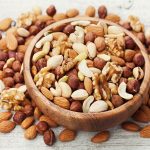
As Americans, we’re making some headway in our efforts to improve the quality of our diet, but we’re far from ideal levels. Research shows that healthier eating prevented over a million premature deaths in the 13-year period from 1999 to 2012, along with 8.6 percent fewer heart disease cases, 1.3 percent fewer cancer cases, and 12.6 percent fewer type 2 diabetes cases. An index that measures diet quality increased from 40 to over 48, but that’s still a long way from the perfect score of 110. Also, most of the improvement came from just two steps — reducing consumption of trans fat (largely because of government action to ban it) and sugar-sweetened beverages. Little progress was made in most of the key components of a healthy diet. An analysis of data from the USDA Economic Research Service by the Pew Research Center found that while we’re eating more chicken and less beef, we’re also each consuming 36 pounds of cooking oil a year — three times the amount Americans ate 50 years ago. We’re also each eating on average 23 percent more calories than we were back then. It’s no wonder obesity rates are so high. And yet it only takes small changes to make a difference. For instance, one report found that what’s needed to turn the average diet into one that can reduce… read on >
























-300x200.jpg)













